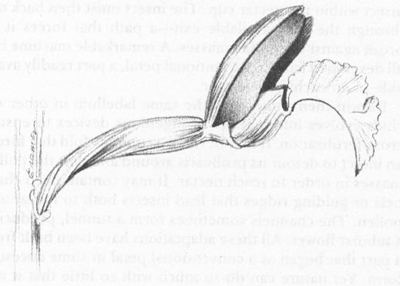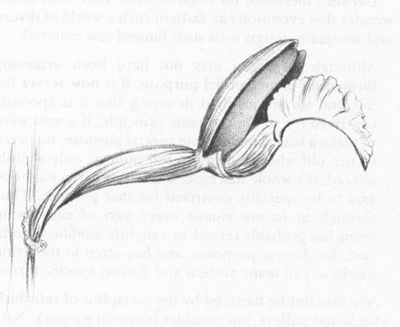The Panda’s Thumb (2 page)
Authors: Stephen Jay Gould

FEW HEROES LOWER
their sights in the prime of their lives; triumph leads inexorably on, often to destruction. Alexander wept because he had no new worlds to conquer; Napoleon, overextended, sealed his doom in the depth of a Russian winter. But Charles Darwin did not follow the
Origin of Species
(1859) with a general defense of natural selection or with its evident extension to human evolution (he waited until 1871 to publish
The Descent of Man
). Instead, he wrote his most obscure work, a book entitled:
On the Various Contrivances by Which British and Foreign Orchids Are Fertilized by Insects
(1862).
Darwin's many excursions into the minutiae of natural historyâhe wrote a taxonomy of barnacles, a book on climbing plants, and a treatise on the formation of vegetable mold by earthwormsâwon him an undeserved reputation as an old-fashioned, somewhat doddering describer of curious plants and animals, a man who had one lucky insight at the right time. A rash of Darwinian scholarship has laid this myth firmly to rest during the past twenty years (see essay 2). Before then, one prominent scholar spoke for many ill-informed colleagues when he judged Darwin as a “poor joiner of ideasâ¦a man who does not belong with the great thinkers.”
In fact, each of Darwin's books played its part in the grand and coherent scheme of his life's workâdemonstrating the fact of evolution and defending natural selection as its primary mechanism. Darwin did not study orchids solely for their own sake. Michael Ghiselin, a California biologist who finally took the trouble to read all of Darwin's books (see his
Triumph of the Darwinian Method
), has correctly identified the treatise on orchids as an important episode in Darwin's campaign for evolution.
Darwin begins his orchid book with an important evolutionary premise: continued self-fertilization is a poor strategy for long-term survival, since offspring carry only the genes of their single parent, and populations do not maintain enough variation for evolutionary flexibility in the face of environmental change. Thus, plants bearing flowers with both male and female parts usually evolve mechanisms to ensure cross-pollination. Orchids have formed an alliance with insects. They have evolved an astonishing variety of “contrivances” to attract insects, guarantee that sticky pollen adheres to their visitor, and ensure that the attached pollen comes in contact with female parts of the next orchid visited by the insect.
Darwin's book is a compendium of these contrivances, the botanical equivalent of a bestiary. And, like the medieval bestiaries, it is designed to instruct. The message is paradoxical but profound. Orchids manufacture their intricate devices from the common components of ordinary flowers, parts usually fitted for very different functions. If God had designed a beautiful machine to reflect his wisdom and power, surely he would not have used a collection of parts generally fashioned for other purposes. Orchids were not made by an ideal engineer; they are jury-rigged from a limited set of available components. Thus, they must have evolved from ordinary flowers.
Thus, the paradox, and the common theme of this trilogy of essays: Our textbooks like to illustrate evolution with examples of optimal designânearly perfect mimicry of a dead leaf by a butterfly or of a poisonous species by a palatable relative. But ideal design is a lousy argument for evolution, for it mimics the postulated action of an omnipotent creator. Odd arrangements and funny solut ons are the proof of evolutionâpaths that a sensible God would never tread but that a natural process, constrained by history, follows perforce. No one understood this better than Darwin. Ernst Mayr has shown how Darwin, in defending evolution, consistently turned to organic parts and geographic distributions that make the least sense. Which brings me to the giant panda and its “thumb.”
Giant pandas are peculiar bears, members of the order Carnivora. Conventional bears are the most omnivorous representatives of their order, but pandas have restricted this catholicity of taste in the other directionâthey belie the name of their order by subsisting almost entirely on bamboo. They live in dense forests of bamboo at high elevations in the mountains of western China. There they sit, largely unthreatened by predators, munching bamboo ten to twelve hours each day.
As a childhood fan of Andy Panda, and former owner of a stuffed toy won by some fluke when all the milk bottles actually tumbled at the county fair, I was delighted when the first fruits of our thaw with China went beyond ping pong to the shipment of two pandas to the Washington zoo. I went and watched in appropriate awe. They yawned, stretched, and ambled a bit, but they spent nearly all their time feeding on their beloved bamboo. They sat upright and manipulated the stalks with their forepaws, shedding the leaves and consuming only the shoots.
I was amazed by their dexterity and wondered how the scion of a stock adapted for running could use its hands so adroitly. They held the stalks of bamboo in their paws and stripped off the leaves by passing the stalks between an apparently flexible thumb and the remaining fingers. This puzzled me. I had learned that a dexterous, opposable thumb stood among the hallmarks of human success. We had maintained, even exaggerated, this important flexibility of our primate forebears, while most mammals had sacrificed it in specializing their digits. Carnivores run, stab, and scratch. My cat may manipulate me psychologically, but he'll never type or play the piano.
So I counted the panda's other digits and received an even greater surprise: there were five, not four. Was the “thumb” a separately evolved sixth finger? Fortunately, the giant panda has its bible, a monograph by D. Dwight Davis, late curator of vertebrate anatomy at Chicago's Field Museum of Natural History. It is probably the greatest work of modern evolutionary comparative anatomy, and it contains more than anyone would ever want to know about pandas. Davis had the answer, of course.
The panda's “thumb” is not, anatomically, a finger at all. It is constructed from a bone called the radial sesamoid, normally a small component of the wrist. In pandas, the radial sesamoid is greatly enlarged and elongated until it almost equals the metapodial bones of the true digits in length. The radial sesamoid underlies a pad on the panda's forepaw; the five digits form the framework of another pad, the palmar. A shallow furrow separates the two pads and serves as a channelway for bamboo stalks.

D. L. CRAMER
The panda's thumb comes equipped not only with a bone to give it strength but also with muscles to sustain its agility. These muscles, like the radial sesamoid bone itself, did not arise
de novo
. Like the parts of Darwin's orchids, they are familiar bits of anatomy remodeled for a new function. The abductor of the radial sesamoid (the muscle that pulls it away from the true digits) bears the formidable name
abductor pollicis longus
(“the long abductor of the thumb”
âpollicis
is the genitive of
pollex
, Latin for “thumb”). Its name is a giveaway. In other carnivores, this muscle attaches to the first digit, or true thumb. Two shorter muscles run between the radial sesamoid and the pollex. They pull the sesamoid “thumb” towards the true digits.
Does the anatomy of other carnivores give us any clue to the origin of this odd arrangement in pandas? Davis points out that ordinary bears and raccoons, the closest relatives of giant pandas, far surpass all other carnivores in using their forelegs for manipulating objects in feeding. Pardon the backward metaphor, but pandas, thanks to their ancestry, began with a leg up for evolving greater dexterity in feeding. Moreover, ordinary bears already have a slightly enlarged radial sesamoid.
In most carnivores, the same muscles that move the radial sesamoid in pandas attach exclusively to the base of the pollex, or true thumb. But in ordinary bears, the long abductor muscle ends in two tendons: one inserts into the base of the thumb as in most carnivores, but the other attaches to the radial sesamoid. The two shorter muscles also attach, in part, to the radial sesamoid in bears. “Thus,” Davis concludes, “the musculature for operating this remarkable new mechanismâfunctionally a new digitârequired no intrinsic change from conditions already present in the panda's closest relatives, the bears. Furthermore, it appears that the whole sequence of events in the musculature follows automatically from simple hypertrophy of the sesamoid bone.”
The sesamoid thumb of pandas is a complex structure formed by marked enlargement of a bone and an extensive rearrangement of musculature. Yet Davis argues that the entire apparatus arose as a mechanical response to growth of the radial sesamoid itself. Muscles shifted because the enlarged bone blocked them short of their original sites. Moreover, Davis postulates that the enlarged radial sesamoid may have been fashioned by a simple genetic change, perhaps a single mutation affecting the timing and rate of growth.
In a panda's foot, the counterpart of the radial sesamoid, called the tibial sesamoid, is also enlarged, although not so much as the radial sesamoid. Yet the tibial sesamoid supports no new digit, and its increased size confers no advantage, so far as we know. Davis argues that the coordinated increase of both bones, in response to natural selection upon one alone, probably reflects a simple kind of genetic change. Repeated parts of the body are not fashioned by the action of individual genesâthere is no gene “for” your thumb, another for your big toe, or a third for your pinky. Repeated parts are coordinated in development; selection for a change in one element causes a corresponding modification in others. It may be genetically more complex to enlarge a thumb and
not
to modify a big toe, than to increase both together. (In the first case, a general coordination must be broken, the thumb favored separately, and correlated increase of related structures suppressed. In the second, a single gene may increase the rate of growth in a field regulating the development of corresponding digits.)
The panda's thumb provides an elegant zoological counterpart to Darwin's orchids. An engineer's best solution is debarred by history. The panda's true thumb is committed to another role, too specialized for a different function to become an opposable, manipulating digit. So the panda must use parts on hand and settle for an enlarged wrist bone and a somewhat clumsy, but quite workable, solution. The sesamoid thumb wins no prize in an engineer's derby. It is, to use Michael Ghiselin's phrase, a contraption, not a lovely contrivance. But it does its job and excites our imagination all the more because it builds on such improbable foundations.
Marsh
Epipactis
, lower sepals removed

a. Runway of labellum depressed after insect lands.
D. L. CRAMER

b. Runway of labellum raised after insect crawls into cup below.
D. L. CRAMER
Darwin's orchid book is filled with similar illustrations. The marsh Epipactus, for example, uses its labellumâan enlarged petalâas a trap. The labellum is divided into two parts. One, near the flower's base, forms a large cup filled with nectarâthe object of an insect's visit. The other, near the flower's edge, forms a sort of landing stage. An insect alighting on this runway depresses it and thus gains entrance to the nectar cup beyond. It enters the cup, but the runway is so elastic that it instantly springs up, trapping the insect within the nectar cup. The insect must then back out through the only available exitâa path that forces it to brush against the pollen masses. A remarkable machine but all developed from a conventional petal, a part readily available in an orchid's ancestor.
